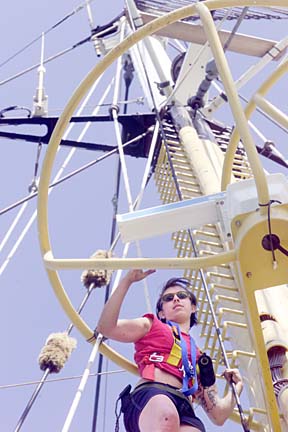


|
The SSV Robert C. Seamans is a 134-foot steel sailing vessel, outfitted with some of the most advanced scientific equipment available. Students grow close
attending college at seaThe floating campus offers an
opportunity to study the ocean
and build relationshipsBy Diana Leone
dleone@starbulletin.comIts acoustic Doppler current profiler uses sound to map ocean currents -- and even the daily movements of the microscopic plankton suspended in the water.
Another computer program maps the ocean floor at depths of up to 4,500 meters.
It's not your typical college classroom.
Then again, six weeks at sea on this teaching vessel owned and operated by the Sea Education Association of Woods Hole, Mass., isn't your typical college semester, either.
Over the next few months, the impressive ship, just a year-and-a-half old, will be docked at Aloha Tower in between several six-week long "semesters at sea" and a few shorter voyages.
It arrived in Honolulu Tuesday with 25 undergraduate student-sailors and a teaching crew of 11. Since Dec. 9, the group had sailed 5,500 miles from Puerto Vallarta, Mexico, to Hawaii, by way of the equator, spending Christmas and New Year's at sea.
Along the way, the students were responsible for keeping round-the-clock watch of the ship, participating in sailing it, maintaining it and feeding each other, in addition to a rigorous class schedule and conducting oceanography experiments they designed themselves. They prepare for the shipboard work with six weeks of classroom training in Woods Hole.
They learned to sail the old-fashioned way, with paper charts, navigational tables and sextants, said Capt. Sean Bercaw. And the modern way, with electronic charts and satellite weather reports.
But more than a semester's college credit and seamanship skills are gained on these voyages, students and crew said last week as they cleaned the ship.
"When the closest land is 1,500 miles away, you have to take everything with you and use what you have," geologist Jim Foley said. "A unique community builds aboard the ship. Living and working together six weeks is pretty interesting."
"There are no words" for the experience of seeing the students grow as people during the voyages, said Colleen Allen, as she paused in peeling shrimp in the galley. Allen was a student-sailor in 1984 and since 1994 has been a staffer on Sea Education Association ships. (There are two, one based on the East Coast and one on the West Coast.)
"They learn a lot about themselves," Bercaw said. And after 13 years on these teaching voyages, he's given up trying to predict which students will take to it. Sometimes a student who is bright and enthusiastic doesn't cope well with the limits of the ship environment, he said. On the other hand, "sometimes the wallflower really blossoms."
Would-be disasters, like losing a sail or making it through a rough gale, end up being the things that draw the team together, Bercaw said.
"The ship is so safe and the crew so well-trained that nothing happens that can't be handled," Allen said.
The semester at sea costs more than $12,000, but, as with most higher education, there is financial aid available. About half of the students are science majors. The rest are majoring in anything from art to history to literature.
Student Jonatha Giddens said she had "romantic" ideas of sailing on the ocean when she signed up for the voyage. But it was the hard work of scrubbing the ship floor on her hands and knees during "dawn patrol" that "helped me learn most about how to make living really nice," she said.
(She also completed her oceanography project about the movement of equatorial ocean currents.)
The camaraderie of the crew was evident last week as one student left the ship for good. She got on the ship's intercom system and announced, "I'm in the doghouse if you want to say good-bye," using the sailor's nickname for the main navigating area of the ship.
Like a flash, the five people calmly chopping fruits and vegetables for dinner in the ship's galley put down their knives and went to bid one of their family a fond farewell.
For more information about the Sea Education Association, see www.sea.edu.